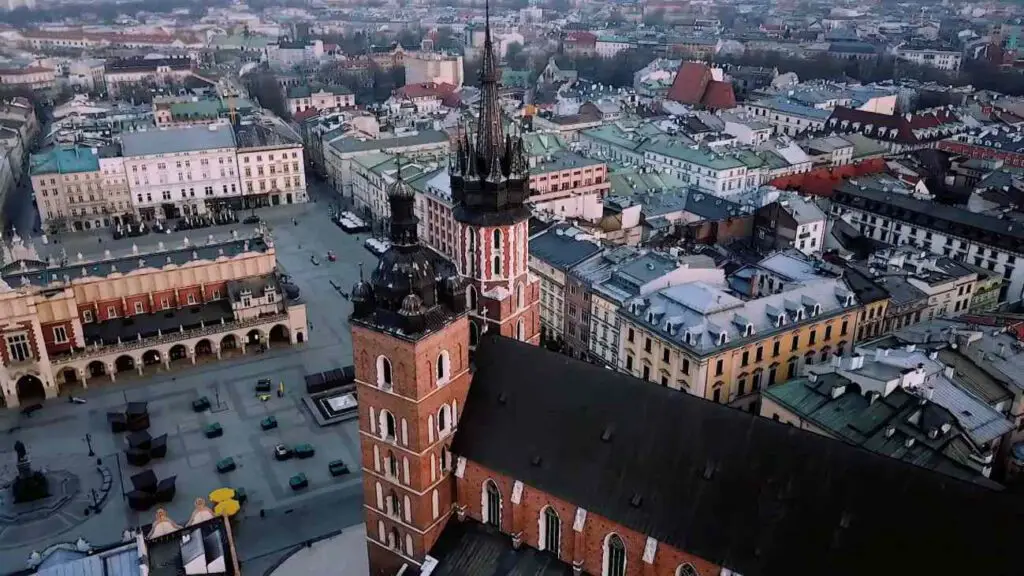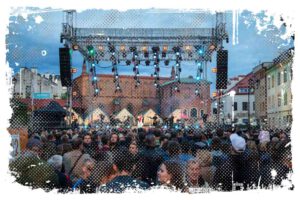When you stand before the magnificent facade of St. Mary’s Basilica in Krakow, you can’t help but notice the two distinct towers that frame it. These towers, though different in height, are each fascinating in their own right. They are more than just architectural marvels; they are storied structures that have stood the test of time.

If you’re interested in the towers I suggest you read the guide I wrote about the St. Mary’s Basilica in Krakow.
Here are the most important data about the St. Mary’s Basilica and Krakow.
| Category | Data |
|---|---|
| Name | St. Mary’s Basilica |
| Location | Kraków, Poland |
| Denomination | Roman Catholic |
| Architectural type | Gothic-style |
| Founder(s) | Casimir III the Great |
| Completed | 1347 |
| Height | 80 m (262 ft) |
| Notable Features | Wooden altarpiece carved by Veit Stoss |
| History | Built in the 14th century, with foundations dating back to the early 13th century. Destroyed during the Mongol invasion of Poland. Rebuilt between 1290 and 1300 in early Gothic style. |
| Recognition | UNESCO World Heritage Site, Cultural: iv |
The Majestic North Tower

The higher of the two towers, known as Hejnalica or the Watchtower, stands at an impressive 82 meters. Built on a square plan, the tower transitions into an octagon at the ninth floor, complete with ogival recesses that house two floors of windows. Stone cornices neatly separate the individual storeys. In the past, a clock with moving figures adorned this towwer, adding to its charm.
↳ Make sure to read my guide to the most amazing places to stay in Kraków:
How to Find Best Place to Stay in Krakow Old Town – Your Guide
The tower is crowned with a gothic helmet from 1478, a masterpiece by master Maciej Heringek. This helmet consists of an octagonal, pointed spire, surrounded by a wreath of eight lower turrets. The view from the tower, at a height of 54 meters, is breathtaking. If you want to experience a piece of history, you should know that the bugle call of St. Mary’s is played from this tower every hour.
At the foot of the tower, on the north side, there is a rectangular annex with stone stairs leading to the inside of the tower. Being there, you need to know that an impressive bronze plaque depicting King Jan III Sobieski, designed by sculptor Pius Weloński, graces the left side of the entrance. It was made to celebrate the 200th anniversary of the relief of Vienna.
The Stately South Tower
The south tower, though shorter at 69 meters, is no less remarkable. Serving as a belfry, this tower, like its taller counterpart, was erected on a square plan and has a clearly marked division of storeys with cornices and windows. The first floor houses the Renaissance chapel of St. Conversion of St. Paul, accessible through a balcony, the work of Italian masters from the workshop of Bartholomew Berecci.
The tower is covered with a late-Renaissance helmet made in 1592, consisting of an elliptical dome set on an octagonal drum, topped with an openwork lantern. Four smaller domes on low, hexagonal bases sit at the corners.
The Legend Behind the Basilica Towers’ Height Difference

The differing heights of the towers have a legend attached to them. Acording to the story, two brothers, known as the best builders in Krakow, were employed to construct the towers. The elder brother was tasked with building the south tower, and the younger one, the north tower.
Initially, the construction progressed smoothly, with both towers rising at a similar pace. However, it soon became evident that the south tower, under the elder brother’s watch, was growing taller than the north one. Consumed by jealousy, the younger brother killed the elder in a fit of rage. He ordered the unfinished southern tower to be covered with a dome, and he completed the construction of his now taller, northern tower as planned.
However, his guilt did not let him live in peace. On the day of the solemn consecration of St. Mary’s Church, he confessed to the murder publicly, then jumped from the top of his tower.
The knife he used to kill his brother still hangs in the gate of the Cloth Hall on the Main Market Square, a grim reminder of the tragic event.

The Legend of the Trumpeter and the Bugle Call
In the Middle Ages, the bugle call was played from the higher tower, serving as the city watchtower. This was a signal to open or close the city gates of Krakow. More importantly, it served as a warning for the appearance of a fire or the arrival of an enemy.

The legend of the intermittent bugle call dates back to the 13th century when Polish lands were victim to Tatar raids. A guard in St. Mary’s Tower, responsible for the safety of Krakow’s inhabitants, would play the bugle call upon sighting the Tatars approaching the city. Tragically, as he sounded the alarm, a Tartar arrow pierced his throat. To this day, the bugle call stops at the same moment to honor the memory of the brave trumpeter, who alerted Krakow to the impending danger.
The Golden Crown on Hejnalica
I believe it is worth mentioning that the top of the higher tower is adorned with a royal crown belonging to Mary as the Queen of Poland. The first crown was made in 1628, following the revelations of the Italian Jesuit Father Giulio Mancinelli, in which Mary recommends calling herself the Queen of Poland.
The next crown, which still exists today, was made in 1666, on the tenth anniversary of the weddings of King John Casimir in Lviv and the official proclamation of Mary as the Patroness and Queen of Poland. The crown, shaped like an upwardly extended octagon, is made of copper sheet and covered with gold.
Conclusion
The architectural styles of these towers differ, adding to the mystery of their design. I am convinced that this unique feature was intentional, though the exact reason remains unknown due to the absence of any architectural plans explaining it.
If you are ever lucky enough to be there, you need to know about the traditional melody that echoes from the Bugle Call Tower. A trumpeter performs this bugle call, creating a beautiful, melodious atmosphere that adds to the charm of the Basilica.
To sum it up, I believe the towers of St. Mary’s Basilica are not just a distinctive feature, but they also significantly contribute to the architectural beauty and historical significance of the church. So, if you ever find yourself in Kraków, make sure to pay a visit to this iconic monument.
References:
– http://krakow.travel/en/artykul/117/legend-of-the-two-towers-of-st-marys
– https://mariacki.com/en/st-marys-basilica/st-marys-towers/
– https://en.wikipedia.org/wiki/St._Mary%27s_Basilica,_Krak%C3%B3w
– https://visitkrakow.com/st-marys-basilica/
– https://theuniquepoland.com/st-marys-basilica-krakow




